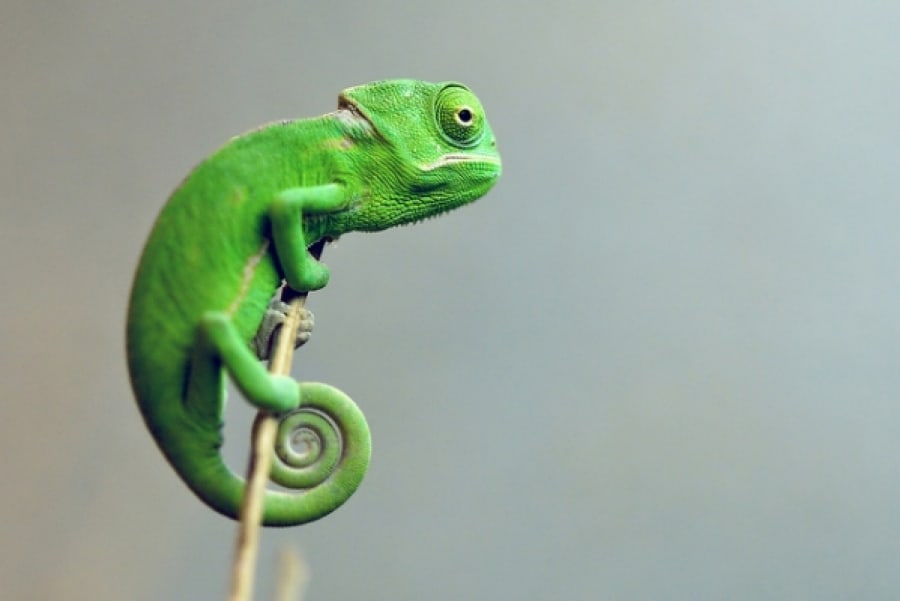
Caring for a veiled chameleon can be challenging even for an experienced reptile pet owner. Indeed, they are exotic animals that need proper care to thrive.
If you are looking for complete guides that can help you to take good care of your lizard, you have landed on the right page. In this caresheet, we have covered everything about veiled chameleon care that will help you succeed in this.
Here’s the list of veiled chameleon care for the habitat setup, housing, diet, hydration, behavior, handling, breeding, and much more!
- Information
- Habitat
- Food and Diet for Veiled Chameleon
- Feeding
- Drinking Water and Hydration
- Housing and Setup
- Housing The Veiled Chameleon
- Habitat Maintenance
- Health and Preventive Care
- Common Health Problems
- Handling
- Behavior & Temperament
- Breeding
- Choosing a Veiled Chameleon as a Pet?
Information
- Scientific Name: Belong to the Chamaeleonidae family and are known as Chamaeleo calyptratus.
- Common Name: Known as Yemen chameleons due to its origin.
- Origin & Native Habitat: Initially found in the arid valley along the mountain areas, from Arab Saudi to Yemen, primarily in Yemen’s grasslands and plateau. These are rainforest areas with heavy rainfall each year.
- History: It was the pet traders who introduced them to the pet market in Florida and Maui of Hawaii.
Description
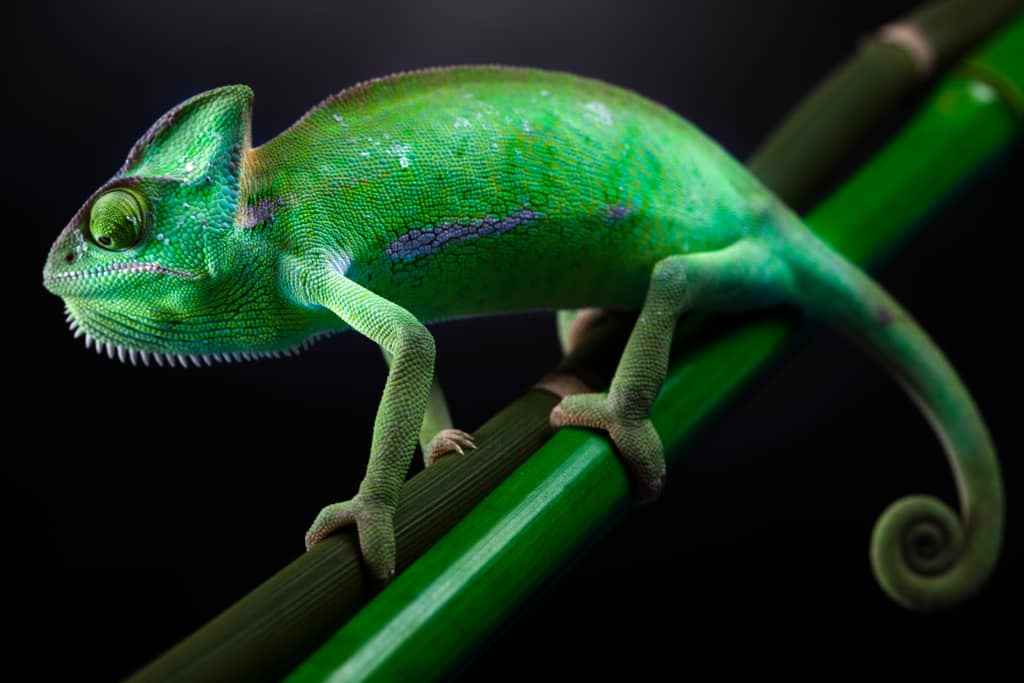
The veiled chameleon is a colorful reptile, fragile that needs proper care to grow healthily and happily. This reptile is not a pet for the absolute beginners.
The easiest way to distinguish the veiled from other chameleons is the tall casque or appendage found on top of the head, which looks like a helmet. Usually, the male casque is noticeably larger than the female if they are of the same size or age.
They have big eyes pivot on turrets and can swivel 180° and look at any direction without turning their heads. Though they are slow, their tongues are fast and long, about 2.5 times the length of their body if fully extended, making them a good insect hunter when it comes to hunting food.
The tail is prehensile and acts as fifth legs for balancing and stabilization to hold onto branches. They have zygodactyl feet, meaning the toes are opposite each other. And with sharp nails, they have a good grip on branches.
The reptile is an omnivore, meaning they eat feeder insects (source of protein), fruits, and vegetables.
Lifespan
The average lifespan of the chams in captivity is about 6 to 8 years, depending on sex. Male can live about 8 years while a female has a shorter lifespan due to wear out in laying infertile eggs over the years.
Color
Like other lizards in nature, males are brighter in color, banded in the shades of bright greens yellow, and brown, while females are green without any color pattern.
Size
On average, the size measured from snout to the tail of a veiled chameleon is as table below:
| Average Size of a Veiled Chameleon | Total Length |
|---|---|
| Adult Male | 18 to 24 inches (about 12 inches from snout to vent) |
| Adult Female | 10 to 13 inches (about 6 inches from snout to vent) |
| Baby Veiled Chameleon | 3 to 4 inches |
Habitat
Natural Habitat
In nature, Veiled Chameleons are found in Coastal Plains, Western Slopes, and Highland Plateau of Western Yemen. Most pets found in the US and UK are from Western Slopes, where the habitat is ideal for the veiled chameleon to thrive.
Western Slopes is an arid valley with abundant rainfall that is humid and not too hot. Grains, fruits, and vegetables grow well in this area. Fogs in the lush forests encourage a massive population of insects. Together with favorable weather, both food sources have encouraged the growth of veiled chameleons in this area.
Habitat Setup in The Captivity
As a reptile owner, you should try to emulate and mimic the natural habitat for the housing environment to make sure your veiled chameleon lives happily and healthily.
Things to consider are lighting, temperature, and humidity. Ensure the setup is appropriate for the day and night. Do consider the weather for the different seasons, such as hot summer and cold winter as a factor when setting up the enclosure.
Food & Diet
The veiled chameleon is an omnivore lizard. They are ambush insectivores, eat live invertebrates, fruit, and vegetables in the wild.
As a pet owner who is solely responsible for the reptile well-being, you need to supply a variety of insects whenever possible. The key to good health is a balanced diet. Always try to provide a good source of nutritious food to your veiled chameleon.
Here is the list of food you need to provide to your cham:
- Feeder insects.
High-quality crickets are always the primary source of protein to the reptile. Breed crickets on your own if it is possible due to the hygiene. To avoid nutritional imbalance, you may need to provide different insects such as roaches, silkworms, grasshoppers, superworms, flies, hornworms, walking sticks, or caterpillars. You need to minimize the usage of waxworms as they are high-fat food. Do not feed with beetles and mealworms frequently as they are hard to digest. Avoid fireflies and lizard ants. Also, be wary of wild-caught insects as they are always exposed to pesticides. - Vegetables and fruits.
Occasionally, you need to provide some fresh vegetables or fruits such as dandelion leaves, collard greens, kale, mustard greens, romaine lettuce, green leaf lettuce, blueberries, mango, grapes, spinach, thin slices of apples, pear, peaches, diced carrots or zucchini. Please ensure that the live plants in the chameleon’s enclosure are non-toxic, as they will occasionally eat them. - Calcium supplements and vitamins.
To promote proper growth, health, and avoid nutrition inefficiency, you need to supplement the foods with reptile calcium, and multivitamin supplements. Always select products that do not contain vitamin A, D3, or phosphorus, as they can easily cause an overdose of vitamin intake that eventually becomes harmful to your chameleon.
Feeding
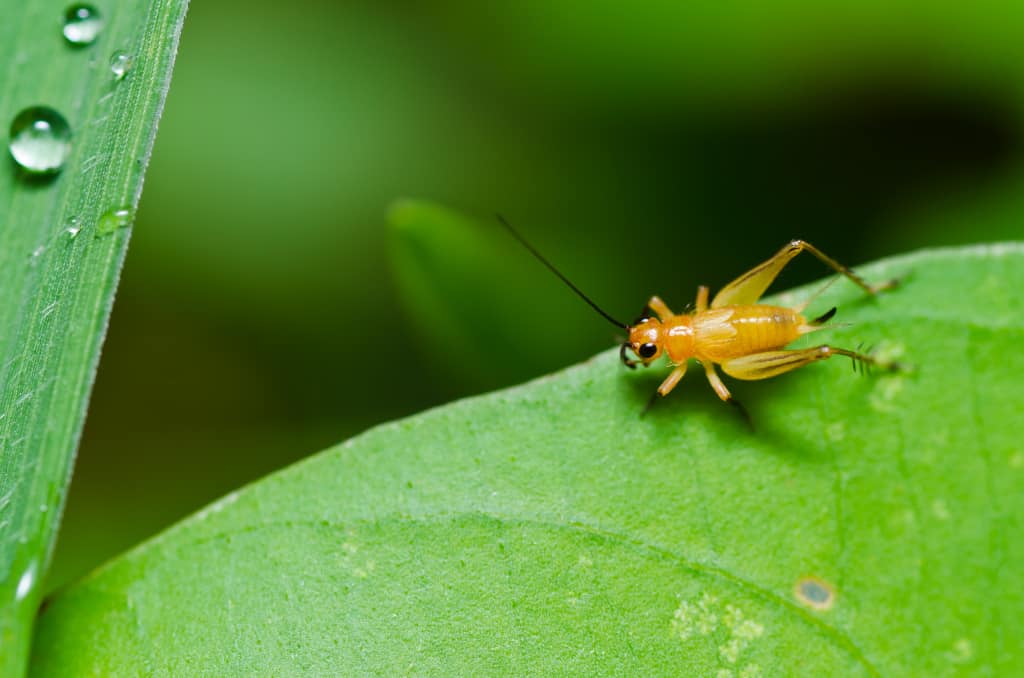
The combination of food or feeding frequencies for a baby, juvenile, or adult cham is different. The table below provides you the guideline in feeding the chams:
| Veiled Chameleon Feeding | Baby or Juvenile | Adult |
|---|---|---|
| Food combination | More than 70% are insects to promote growth | More than 50% are insects with more vegetation |
| Food size | Pinhead crickets or insects | Small crickets or insects preferred |
| Feeding Frequency | 1 to 2 times a day | Every other day |
| Calcium Dusting | 3 to 4 times a weekly | 1 to 2 times a week |
| Multivitamin Supplement (free of phosphorous) | Once every week | Twice every month |
It is always good to feed small live feeder insects to the lizard so they can easily swallow and digest. The feeder insect size should be the same or smaller of the length between their eyes.
To make the foods more nutritious, always gut loading the prey 24 to 48 hours before feeding them. It means that feeding the feeder insects with greens, fruits, commercial cricket diets, calcium, or supplements so that the live foods are nutritious to the chameleon. This is vital for growing babies, juvenile or breeding females.
After the prey are gut loaded, always dust or sprinkle them with commercial calcium powder and supplement immediately before placing them in the enclosure for feeding. Placing the prey in a plastic container is still considered the best feeding method. It allows you to monitor the prey consumption, and it is easier to contain the live insects and reduce the chances of escaping.
If you would like to provide leafy greens or fruits, cut them into small pieces and place in a dish. The chameleon spends most of the time on the branches; hence you need to make sure the dish is close to the branch, easily accessible, and does not fall.
Always start with a small meal and monitor their food consumption. You need to bear in mind that the chameleons are prone to over-eating. Increase the feeding amount if needed, while you may need to reduce the food if there is too much uneaten food.
Make it a good habit and routinely check the enclosure by the end of the day and remove the live prey from the enclosure as they might attack your veiled chameleon. Remove the unfinished vegetations or fruits as well because it will promote the growth of bacterias and cause unnecessary infection.
Drinking Water & Hydration
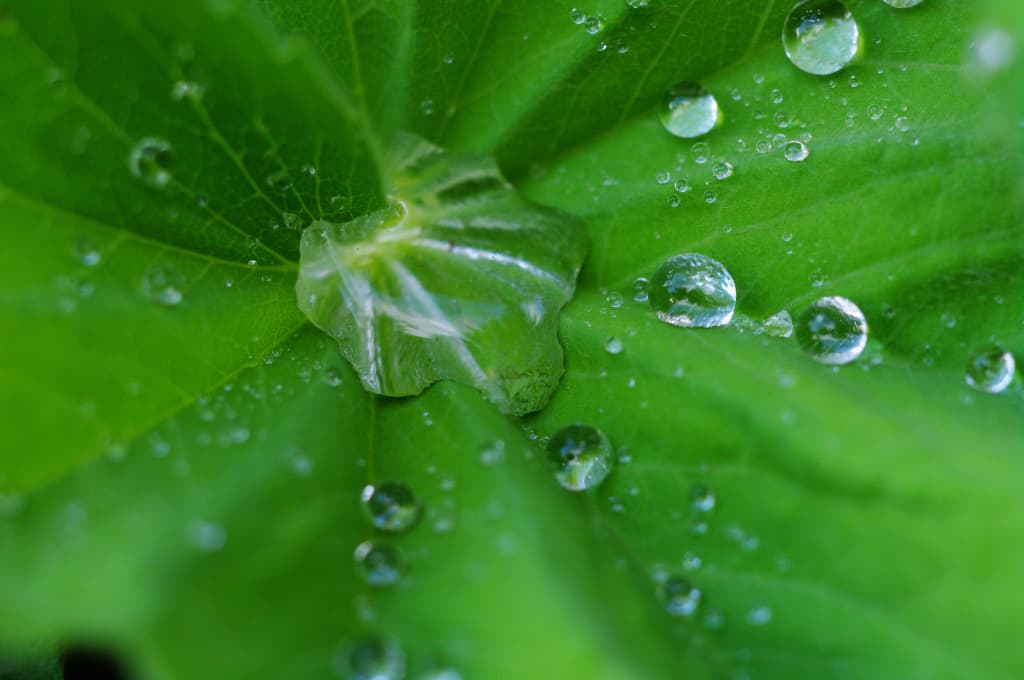
The veiled chameleons always drink from the water droplets off the leaves from misting. Naturally, the tall casque of the head will collect the dew, condense it into water drops and trickle it down to the mouth. Or, they will lap the moisture from the leaves. Thus, you need a professional reptile misting system to get the job done.
Generally, you need to activate the misting system for about 2 minutes twice a day. Try to mist the enclosure, branches, and leaves in the morning to emulate the morning dew and do it again in the evening. Place the misting system properly and avoid misting the lizard directly as it might create stress for some individuals.
Use a water drip system as an alternative hydration solution if you have a constraint budget. You may utilize an electronic timer to control the water flow and drip out the water from the water container on preset time. The water spatters on the leaves. The chameleon will drink the droplets from the leaves and branches around their surroundings.
Also, you should place a water bowl as a secondary source of water if the water generated from the misting system or water-dripping system is insufficient. Sometimes they might fail.
Housing & Setup
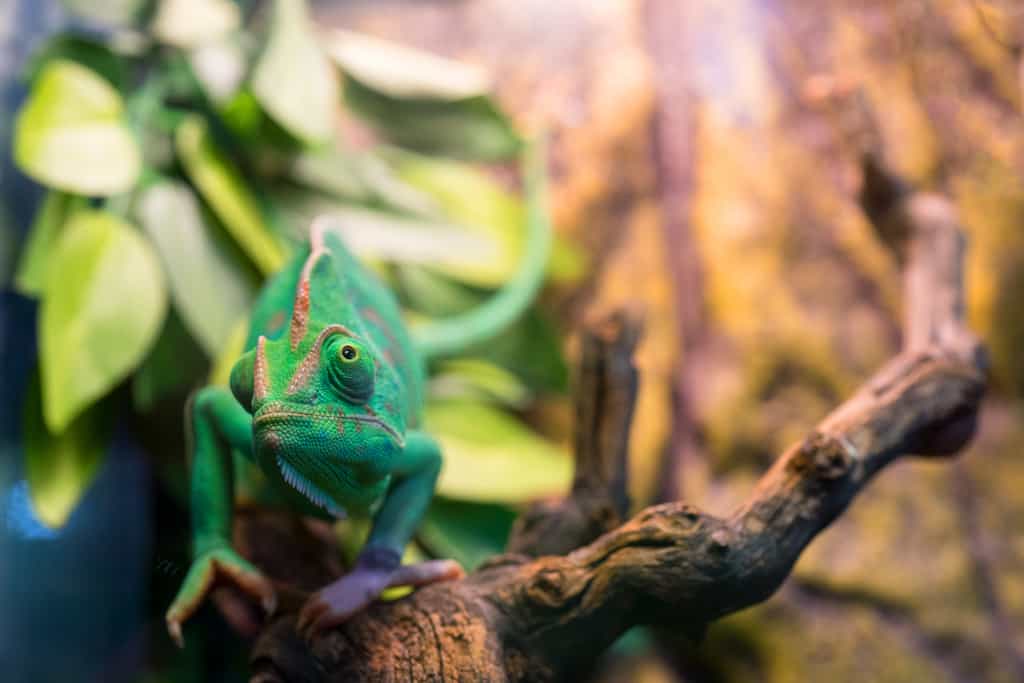
This reptile is a fragile animal and sensitive to its environment and surroundings even though it looks sturdy. There are several factors you need to consider before setting up the cage:
1. Types of Enclosure
Construction of the enclosures is very important. There are several types of cages designed for chameleons, such as:
- Mesh Enclosure.
The cage is generally constructed with vinyl-coated or PVC coated mesh. It allows for excellent ventilation. We do not recommend enclosures built with the fine, rough, or fiberglass mesh because it might cause injuries to veiled chameleon feet. - Glass Tank or Terrarium.
If you are staying in a freezing area, this can be an option, as a glass enclosure usually contains the heat well. However, we do not recommend this solution. Glass tanks can be overheated most of the time, and the self-image reflection of the veiled chameleon can be perceived as another reptile and stress him up. Also, glass and plastic tend to block the UV rays. If you have a glass or plastic lid, ensure the UV source is hanging inside the enclosure.
2. Cage Size
The size of the cage should be large enough for one veiled chameleon to roam around. Vertical space is an essential criterion to consider as they are arboreal animals, meaning they like to climb high up off the ground and spend most of their time on trees.
- Adult male: 24 in x 24 in x 48 in
- Adult female: 18 in x 18 in x 36 in
- Baby or juvenile: 16 in x 16 in x 30 in
The sizes are the minimum requirements. You may opt for a larger or taller enclosure if you have more resources.
3. Lighting
The best lighting option is the natural sunlight. If you house the veiled chameleon indoor, you need to provide at least 12 hours of UV rays a day. This is a minimum photoperiod that is required for healthy behavior, synthesized of vitamin D into D3 for calcium absorption, and prevent MDB (metabolic bone disease)
And to make sure the light source won’t affect the chameleon’s daylight rhythms, you may use a 0.5 to 10.0 UVB bulb or full-spectrum fluorescent tube with an automatic electronic timer. Another option you have is red light bulbs or ceramic elements.
Place the light source about 6 to 8 inches above the highest perches as the light is generating heat and may burn your lizard if it touches the light.
Make sure plastic or glass is not blocking the UV rays into the enclosure. Replace the UV light even if it is still emitting the light after 3 to 4 months because the UV supply may fail, even the light is still working. Always check the manufacturer recommendation for the product lifespan. Alternatively, you can get a UV meter to check if the source is in good condition.
4. Temperature & Heating
Reptiles are ectothermic, meaning they require an external heat source for the metabolic processes. In the wild, veiled chameleons bask themselves under the hot sun and hide under the shades to escape from the high temperature. You need to create a surrounding that can mimic the natural environment.
Light sources can be a heat source. If you have the light as the heat source during the day, you need to turn it off and use a heat emitter during the night. However, using a dedicated heat source to create a basking spot is better as it can regulate the body temperature more effectively.
As the chameleon spends most of the time on the branches, using heat rock, tape, or pad is not suitable. The better option is the ceramic heat bulb with an incandescent fixture.
You need to create a gradient temperature inside the enclosure, with the highest temperature at the top and cooler area at the bottom of the cage.
- Day temperature: 72°F to 80°F.
- Basking spot temperature at the highest perch: 85°F to 95°F. Never above 105°F
- Night temperature: Never below 65°F to 70°F
Like lighting, you should place the heat source outside the cage, about 8 to 12 inches away from the basking spot. The purpose is to prevent your reptile from getting close to the heat source and get burned.
It is important to use a temperature gun to measure the temperature on different spots inside the enclosure. Fix at least 2 digital thermometers to have accurate readings, 1 at hot spot, and another 1 at the cooler area.
5. Humidity & Water
Veiled chameleons favor a properly-set humidity enclosure. You can create the relative humidity level at about 60 to 80 percent using a commercial reptile misting system. If you are on a limited budget, a hand mister may also work.
You need to clean the humidifiers or dripping system every week to prevent bacteria and molds. A contaminated water source may result in eye infections and breathing issues.
Not to mention, they acquire the water off the droplets on the leaves and breathe through the moisture air. Thus, attaching a hydrometer inside the enclosure to measure the humidity is crucial. And make sure to monitor the moisture and set the misting correctly as low humidity can cause kidney disease in lizards.
6. Furnishings & Accessories
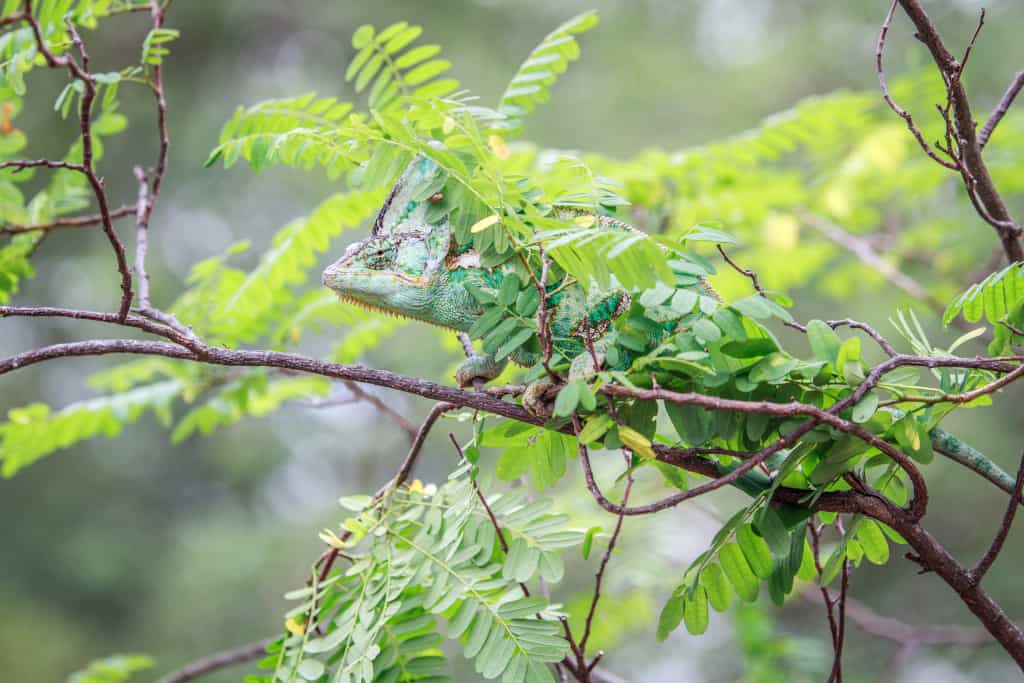
Veiled chameleons are primarily tree-dwellers. You can place branches and woods inside the enclosure for them to climb. Consider using springy wooden perches to allow them to stretch their feet and rest on softer surfaces.
Live plants such as vines and foliage are a must. You may add varieties of non-toxic plants such as Pothos, cistus, Schefllera, or hibiscus. Other than providing water droplets, these plants serve as a food source to the reptile. The lizard feels secure to rest and hide under the cover of leaves, which can also be the shades that allow them to stay away from the heat source.
Try to avoid ficus trees because this plant can be irritating to some chams. Rope perches are not recommended because when the perches start to fray, the pieces can wrap around the chameleon’s toes and nails and cause injuries.
Between, synthetic plants and hammocks can be used supplementarily to live plants as shades and places to rest. Use some artificial branches for supports if needed. Shed box or hide box can provide additional hiding places if there are not enough plants for coverage. These items require less maintenance.
7. Substrate
There no special bedding is required for a veiled chameleon enclosure. Solid substrates such as paper towels, newspaper, reptile liner, or reptile carpet are the preferred choices. These substrates are inexpensive and make cleaning easy. There is no place for the unfinished live feeder insects to hide and easy to remove. You may clean up the feces and urate output easily to prevent the growth of bacteria and fungus.
Do not use beddings such as wood chips, sands, gravels, or other fine substrates that are hard for cleaning and maintenance. These substrates can be troublesome to your reptile as they may accidentally ingest and cause impaction.
Housing The Veiled Chameleon
Veiled chameleon is a solitary reptile in the wild. Therefore, always house a single veiled chameleon in every enclosure when it reaches maturity around 8 to 10 months old. This lizard is territorial, notorious, and acts aggressively towards other parties, especially male chameleons. They only tolerate the presence of other counterparts during the breeding season.
If you have multiple enclosures placed side by side, make sure they do not have direct visual contact with each other. This will create stress for both chameleons and end up with unnecessary illness.
Habitat Maintenance
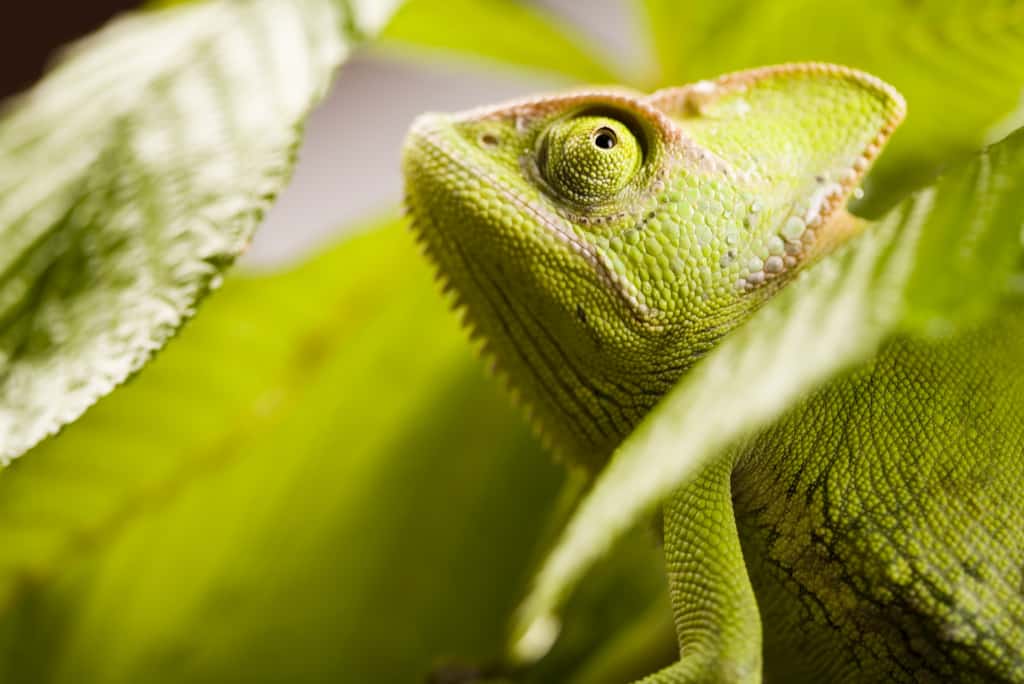
Cleanliness of the enclosure is vital for your veiled chameleon health. You need to disinfect and clean the enclosure thoroughly at least once a week. Here is the checklist for the cage maintenance and cleaning:
- Scrub the furnishings with a 3% reptile-safe bleach solution, and rinse them with water.
- Remove all the feces and urate waste.
- Replace the disposable substrate.
- Clean the misting system for the veiled chameleon.
- Dry the enclosure, decors, and furnishings.
- Regularly check with UV of the emitting sources.
- Ensure the basking spot and temperature gradient are within the permitted range.
- Make sure there is no more bleach smell before placing the lizard back to its home.
Health & Preventive Care
Veiled chameleons are a challenging reptile pet for most beginners. Preventive measures such as proper enclosure setup, well-maintained habitat, clean and nutritious food, and avoid frequent handling to reduce stress. As long as these are taken care of, you will be well assured that you’ll have a healthy and active veiled chameleon.
It is good to take note that their skin sheds regularly. Correct humidity level and providing a shed box with sphagnum moss may assist the shedding process better.
The table below are the signs of good health and red flags for a veiled chameleon:
| Healthy Signs | Sick and Alarming Signals |
|---|---|
| Active | Tired and difficult breathing |
| Always alert to the surroundings | Lethargy and sluggish |
| Bright and clear eyes | Drowsy, cloudy and non-rotating eyes |
| Filled body and tails | Weight loss |
| Good appetite | Do not eat well |
| Clear vent and nose | Mucus around mouth and nose |
| Healthy skin | Swelling, sores, dry patches or bumps on the skin |
| Paralysis of limbs or wobbly legs | |
| Injuries or abnormal cut on toes, nails or skin |
Common Health Problems
Preventive care is always better than cure. By better understanding the causes of the most common veiled chameleon disease, you can take better precautions and learn how to prevent your beloved reptile from getting sick.
- Metabolic Bone Disease (MSB):
MDB is also secondary hyperparathyroidism. The signs are wobbly limbs or legs. It is the common fatal disease, which is mainly due to insufficient UVB light. Make sure you have the proper lighting for your veiled chameleon. - Respiratory Disease:
The signs are mucus around mouth and nose, lethargy and labored breathing. This might have resulted from the contaminated water sources and stagnant airflow. Ventilated enclosure, well maintained misting system, and proper temperature gradient will reduce the risk of respiratory disease. - Gastrointestinal Disease:
The symptoms of this disease are loss of appetite, bloating stomach, and other digestive problems. This is mainly due to parasitic infection. Always maintain a clean enclosure for better hygiene and minimize the risk of infection. Try to breed your own insect feeders such as crickets or purchase them from reputable suppliers. - Vitamin Deficiency:
Mainly due to calcium, phosphorus, and Vitamin A deficiency due to poor diet. The vitamin deficiency could result in brittle bones, stunted growth, lethargy, loss of appetite, nose and eye issues, and even a severe kidney disease. Feeding your lizard with nutritious foods is crucial. - Stress-Related Ailments:
Hissing is a sign of stress. Stress is one of the common causes of health problems. Here are some recommendations to reduce the stress:- Do not handle your reptile frequently.
- Place the enclosure at a low traffic area.
- Single pet housing, no reflective wall, or other chameleons around.
- Appropriate temperature settings.
If budget allowed, get your veiled chameleon to the local veterinarian for a check-up every 6 to 12 months. The veterinarian will perform a fecal examination to check if the reptile is healthy.
Handling
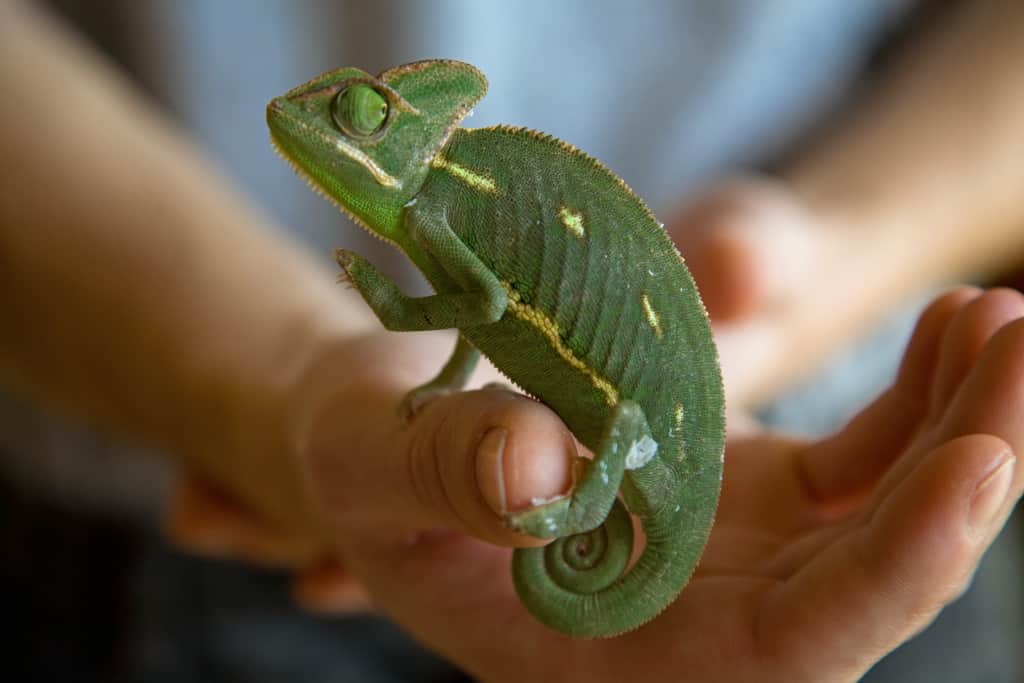
Veiled chameleon is a sensitive animal and does not like handling much. Hence, reduce the handling of your special pet. If you would like to get close to your pet, try to approach slowly. Fast approach will startle and threaten the reptile.
Do not pick it up. Move your hand closer and let it come to you willingly. If it comes over, position your hand under the front feet, and unwind the tail with another hand gently. Do not pull your chameleon off from any object forcefully.
Alternatively, hand feeding can help in handling. Once it knows that your hand is a non-threatening and friendly object, the lizard will love to get close to you.
Behavior & Temperament
One interesting fact about veiled chameleons is that their skin color changes are mainly due to temperature, health, and emotion.
The reptile loves privacy and it gets stressed due to frequent handling. This animal is more suitable for viewing rather than close contact.
Breeding
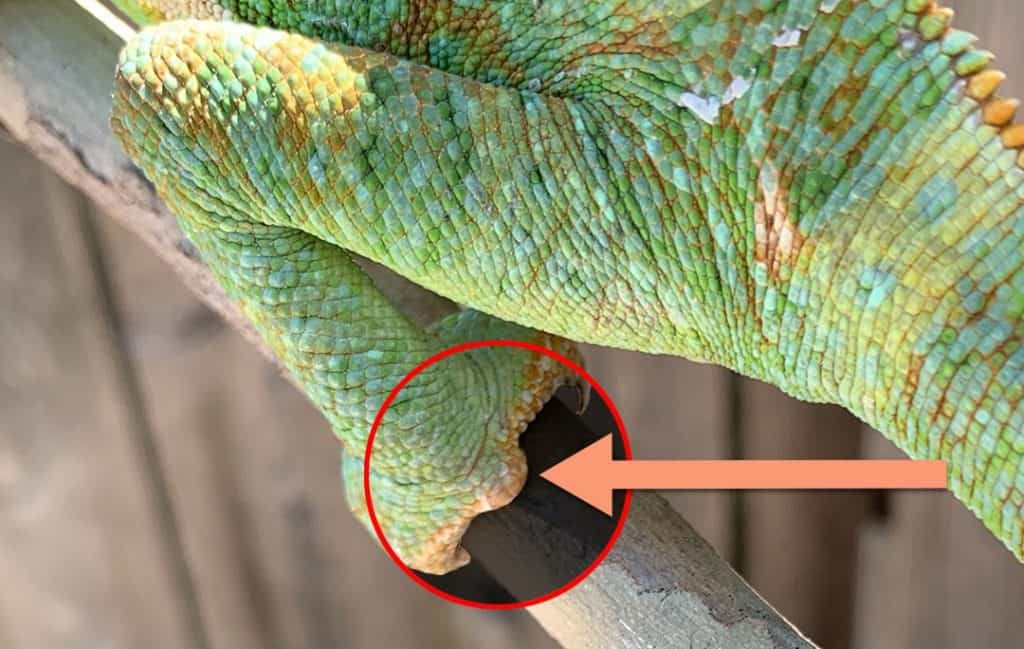
If you have a pair of veiled chameleons and would like to breed them, there are few factors you need to consider.
- Sex:
Make sure you have a male and a female when introducing them in the same enclosure. Male has a tarsal spur on the rear feet. The tarsal spurs are fleshy triangles that look like ankles. - Maturity:
Both chameleons have reached the age of maturity. That is 9 to 12 months. - Health:
They are in good health, active and alert.
Males are more dominant in nature, so you should introduce the female into the male’s enclosure. Keep an eye on the male’s reaction towards the female. Make sure there is no sign of aggression.
If the female is receptive, she will allow the male to approach and copulate her. This may happen several times before she no longer accepts any copulation. The female started to turn dark and colorful; this is the sign of gravidity and no longer receptive to further breeding. You may then separate the female from the male.
The female takes about a month for gestation. She will look for a place for laying the eggs. Get ready a gallon bucket, filled with 1:1 of sand and fine peat moss mixtures. The female will dig a tunnel to lay the eggs. There are about 30 to 80 eggs per clutch.
After the eggs are laid, they can be removed and put in a sealed container with a 1:1 mixture of vermiculite and water by weight. Place the eggs in a dark closet or area at the room temperature of 71 to 84°F. We do recommend an egg incubator for better temperature control. The incubation takes about 5 to 10 months for the eggs to hatch.
Choosing a Veiled Chameleon as a Pet?
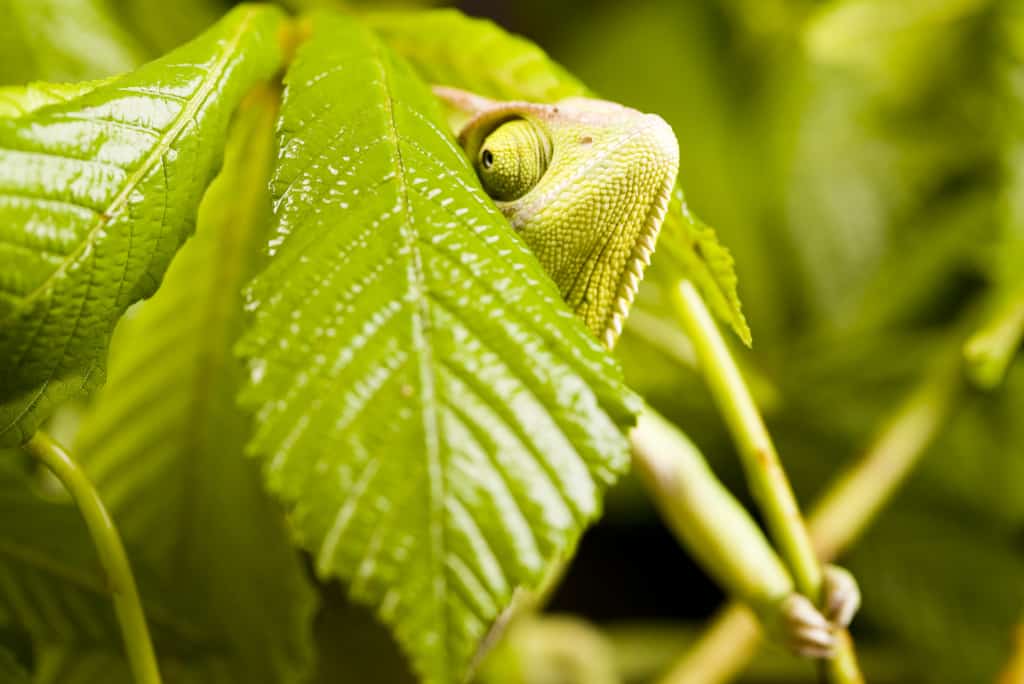
If you are planning to get this fantastic and unique reptile as your pet, there are several factors you may need to consider.
- Captive vs. Wild Breed:
A captive-bred is always more docile and tolerates handling well. Not to mention, they are less likely to have parasites. - Price and Budget:
The prices of the veiled chameleons in the pet market depend on the morph, lineage, sex, age, size, and colors. The cost for a veiled chameleon varies from $50 to $250 in today’s market. - Veiled Chameleon Breeder or Pet Store:
Always find a reputable breeder or a local pet store. You may get better support and professional advice from them. Also, the pet can easily be stressed out if shipping from a distant location. - Male or Female:
Male may live longer and look brighter, while you need a female if you prepare to breed your own baby veiled chameleons. - Cage Size & Space:
You need a minimum of 24 in x 24 cage in footprint space with low traffic to house your reptile. If there is limited space available, it is not advisable to get one.
Conclusion – Taking Good Care of a Veiled Chameleon
It is challenging to care for a veiled chameleon, but regular disciplined practice makes perfect over the time. As long as you have a proper housing setup with adequate UVB lighting, correct heating and temperature gradient, enough nutritious foods, supplements and vitamins, and the enclosure is maintained well, you are certainly doing the veiled chameleon care like an expert.
If you find this veiled chameleon care sheet useful, please share it with your reptile friend or social community. We hope we can help as many reptile enthusiasts as possible so that the pets in captivity receive proper care, especially the new chameleon pet owners.
Recommended Reads:
